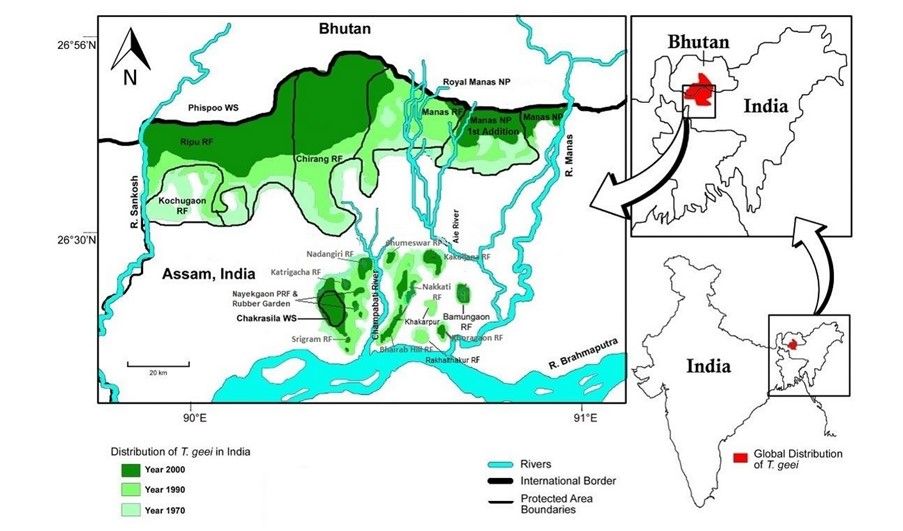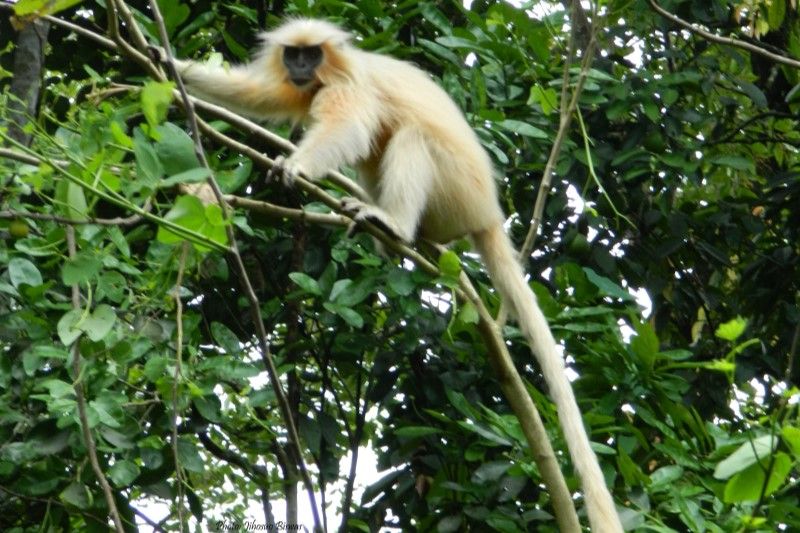Glimmer of hope for golden langurs in India
Golden langur survival in a threatened forest home
Their flamboyant coats bely the fact that golden langurs are in fact shy, elusive primates. Unlike their close cousins, hanuman langurs, which roam the grounds of Indian temples accepting gifts of food, golden langurs live in a forest belt that straddles Bhutan and Assam in north-eastern India.
Fewer than 10,000 remain in the wild. Their northern limit is the range of hills in Bhutan climbing to 2,400 metres above sea level. In Assam, where PTES supports the work of primatologist Jihosuo Biswas, the primates are hemmed in by three rivers – Brahmaputra in the south, Manas in east and Sonkosh in west.
Their ever-dwindling forest habitat is a key threat to their survival. The largest group of langurs lives in Manas Biosphere Reserve in western Assam. The rest of India’s golden langurs live in fragmented populations, nearly all outside protected areas. Their long-term survival therefore depends both on protection from further habitat loss, and reconnection to allow populations to meet and breed.
From forest to Wildlife Sanctuary
Luckily, with funds from PTES, Jihosuo and his team are providing forest officials with key data that will begin to address these threats. Jihosuo met with the Principal Chief Conservator of the Forest (PCCF) and Chief Wildlife Warden of Assam to discuss their findings. The PCCF decided to upgrade Kakoijana Reserve Forest to a Wildlife Sanctuary and include nearly 400km2 of Chirrang Reserved Forest into Raimona National Park.
This shift in status to a protected area, specifically because it’s home to golden langurs, is a great achievement. Kakoijana, home to more than 450 individuals, is a critical area for the species in India and excitingly, the PCCF has begun processing the paperwork needed to upgrade the forest. It is also open to supporting the installation of artificial canopy bridges across highways in the area.
Golden langurs as a flagship species
Golden langurs are also the flagship species behind the declaration of another National Park: Raimona. Together, with the Forest Department and other NGOs, Jihosuo has prepared a draft management plan for the park. This will guide infrastructure development and involve appointing new rangers. Jihosuo aims to connect this forest fragment with others through artificial canopy bridges and green corridors through the villages.
These achievements, which have been spear-headed by Jihosuo and conservationists at Wildlife Trust of India, WWF India, Community Conservation Inc., Green Forest Conservation, Natures Foster and Aaranyak, are the result of years of work. Key to their success has been the involvement of the local communities. Their assistance in planting trees and protecting forests from woodcutters and timber smugglers, has led to increased tree cover and ensured local buy in, essential for the long-term success of wildlife conservation. It means that golden langurs, and other threatened primate species, face a brighter future in this northern Indian state.
Thank you for helping us fund this research to protect golden langurs in India.
If you’d like to support this project please donate or set up a direct debit today.


